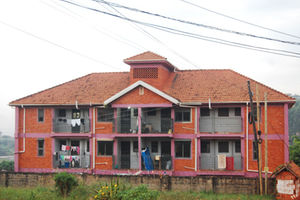
The reality of modern living is that families come in various sizes, and the dynamics can
differ significantly
When Linda Namugerwa, a landlord in Nakawa, Kampala, rented a two-bedroom house to a family of five, she didn’t anticipate the challenges that would arise.
The family soon brought in additional relatives, swelling the total number of occupants to nine.
Within a few months, the increased occupancy led to significant plumbing issues that strained the property’s resources.
This experience prompted Linda to establish strict occupancy rules for her rentals.
She now enforces guidelines on the maximum number of tenants allowed in each house to prevent similar problems in the future.
In Uganda, the dynamics of rental property management often reflect a delicate balance between the expectations of landlords and tenants, highlighting the importance of clear communication and mutual respect in maintaining a harmonious living environment.
One key issue that has come up in recent years is the limit on how many people can live in a rental unit.
While this policy seems simple, it reveals the interests of different groups, including landlords, tenants, and property developers.
It also raises important questions about policies, housing markets and urban planning.
The landlords’ perspective
For landlords, limiting the number of tenants helps maintain the property, reduce maintenance costs, and ensure that their investment lasts longer.
Additionally, some landlords use this as a way to maintain the quality of tenants, which can increase the property’s appeal and rental value.
Landlords stand to benefit significantly from enforcing strict tenant numbers in their properties.
While rental income is a priority, many landlords argue that limiting tenant numbers ensures the longevity of their properties.
“When a house is overcrowded, it experiences faster wear and tear, especially in critical areas like plumbing and electrical systems,” Namugerwa explains.
In an overcrowded environment, the demand on these systems significantly increases. For example, multiple occupants may use plumbing fixtures such as sinks, toilets, and showers more frequently, leading to clogs, leaks, and other issues that require costly repairs.
Similarly, electrical systems can become overloaded when too many appliances or devices are in use at once, raising the risk of outages or even fire hazards.
This accelerated deterioration not only results in immediate maintenance challenges but also diminishes the long-term value of the property.
As a landlord, Namugerwa has found that establishing occupancy limits helps preserve the integrity of her properties and ensures a safer, more comfortable living environment for her tenants.
James Katende, a landlord in Ntinda, a Kampala City suburb, shares a similar concern: “I had to evict a group of tenants who exceeded the agreed number of occupants. The house was intended for four people, but they had more than 10 living there. This not only caused significant damage to the plumbing but also resulted in excessive use of electricity and water. It is a balancing act; while limiting tenant numbers can help protect the property, there is always the worry of losing tenants.”
Landlords face a tough dilemma; they must enforce occupancy limits to maintain the integrity of their properties while also navigating the risk of alienating potential tenants.
For Katende, strict tenant limits are essential for avoiding constant repairs, but he notes that enforcing these rules requires constant vigilance.
"You want to avoid being seen as a difficult landlord," he adds, "but the upkeep of the property depends on it."
Not all landlords take a strict approach. For example, Stella Nakintu, a property owner in Ggaba, believes in a more flexible policy.
“I understand that people are going through hard times,” she explains. “While I do not want too many people living in my houses, I also want to support my tenants. So, I set clear guidelines but allow for some flexibility. I let them know that as long as they maintain the house and do not cause issues for the neighbours, I am open to accommodating larger families.”
Stella’s perspective reflects a compassionate approach to property management, balancing the need for reasonable occupancy limits with an understanding of her tenants' challenges. This strategy not only fosters goodwill but also promotes a sense of community, ensuring that both the property and its residents thrive.
Nakintu is one of the many landlords adapting to the realities of Uganda’s economic situation, where tenants are increasingly pooling resources to survive the high rental prices.
Legal framework
The Rent Restriction Act of Uganda primarily governs rental property regulations, focusing mainly on rent control, tenancy rights, and dispute resolution. However, it provides little guidance on how many people can occupy a single rental unit.
Local authorities especially in urban areas such as Kampala often establish their own guidelines regarding occupancy limits.
Landlords may receive recommendations aimed at addressing concerns about overcrowding, particularly in densely populated neighbourhoods.
Urban planning and health authorities also play a crucial role, as overcrowding can lead to serious issues such as poor sanitation and inadequate living conditions.
In areas like Kampala and Wakiso, overcrowded rental properties have been associated with public health risks, prompting the authorities to enforce stricter tenant limits to ensure the wellbeing of residents.
This multifaceted approach highlights the ongoing challenges of managing rental properties in a rapidly urbanising environment.
John Mugisha, a real estate agent, explains, “Landlords typically impose tenant limits to prevent strain on essential facilities such as water and electricity, which may not adequately support a large number of occupants. Overcrowding can also compromise the structural integrity of a building, leading to costly repairs and safety concerns.”
The tenants’ perspective
For tenants, the question of how many people can reside in a rental property is often tied to considerations of affordability and family size.
Many individuals, particularly those from low-income backgrounds, choose shared living arrangements as a strategy to lower their personal rental expenses.
“I live with my extended family; there are seven of us in total,” explains Sarah Nansubuga, a tenant in Kireka. “We share the rent and utilities, which makes it more affordable for everyone. However, our landlord frequently expresses concern about the number of us living in the house. Sometimes, he even threatens to raise the rent if he feels there are more of us.”
This situation can leave tenants feeling unfairly targeted, especially those with larger families.
They argue that since they pay their rent in full, they should be allowed to live comfortably with their family members without fear of eviction or increased costs.
For many tenants, the ability to share a home with loved ones is not just a matter of preference; it is essential for their financial stability and overall wellbeing.
Tenants frequently grapple with occupancy restrictions, encountering different levels of success in managing their situations. Peter Tumusiime, a tenant in Bweyogerere, shares his experience: “Finding affordable housing is a real challenge, especially when you have a large family. My wife and I have five children, which means we need ample space, but the rent prices are steep. To help with the financial burden, we decided to invite my brother to live with us.”
Tumusiime acknowledges the landlord's concerns, saying, “Our landlord has warned us about overcrowding, but we feel we have no other choice.”
This illustrates the difficult balancing act many tenants must perform as they seek to provide for their families while adhering to the limitations imposed by landlords.
For families such as Tumusiime’s, the necessity of shared living arrangements often outweighs the risk of potential repercussions, highlighting the complex realities of the housing market for those with larger families.
However, some tenants are more fortunate in finding flexible landlords. Betty Mugerwa, a tenant in Namugongo, says, “Our landlord has been understanding. We explained our situation, and he allowed us to stay as a larger group as long as we did not exceed certain limits. We have managed to stay here without trouble.”
Public health and safety concerns
Overcrowding in rental properties poses significant public health risks, particularly in areas with limited access to clean water and proper sanitation.
Health authorities have reported higher rates of disease transmission in crowded areas, as the risk of infectious diseases such as cholera and typhoid increases with poor sanitation.
When too many people live in one household, the strain on water, waste disposal, and cooking facilities is immense.
In some cases, entire families are sharing one toilet facility, which increases the risk of infections.
Enforcing tenant limits can help reduce these public health risks by ensuring that rental units do not exceed their capacity.
Who benefits from limited tenant numbers?
The issue of how many people can live in a rental property in Uganda is complex, shaped by economic pressures, public health concerns, and the interests of various stakeholders.
While strict tenant limits present several advantages, especially for landlords and local authorities they can create significant challenges for tenants who depend on shared living arrangements to manage their rental costs.
Local authorities and public health officials also benefit, as limiting overcrowding addresses public health risks and fosters better living conditions for residents.
From an economic standpoint, real estate investors and developers can see advantages as well.
By limiting occupancy, demand for housing can increase, prompting more construction and investment in rental properties. This can ultimately lead to a more robust rental market.
However, tenants, particularly those from low-income households often feel the negative impacts of these restrictions.
Limiting tenant numbers can heighten their financial burden, forcing them to rent entire units instead of sharing costs with family or friends. This can lead to greater financial strain, making housing less accessible.
“As Uganda continues to urbanise, it is crucial for the government and local authorities to find a balance that considers the needs of all stakeholders,” Mugisha emphasises.




